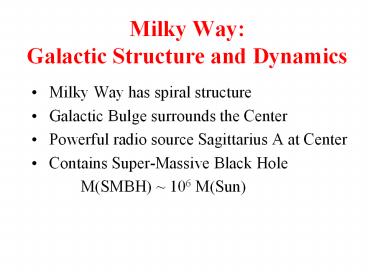Milky Way: Galactic Structure and Dynamics - PowerPoint PPT Presentation
Title:
Milky Way: Galactic Structure and Dynamics
Description:
... Pulsating Cepheid, RR Lyrae Stars Apparent Magnitude (m) vs. T(d) Shape and Constituents of the Galaxy Most of the matter in the Galaxy is not visible ... – PowerPoint PPT presentation
Number of Views:186
Avg rating:3.0/5.0
Title: Milky Way: Galactic Structure and Dynamics
1
Milky WayGalactic Structure and Dynamics
- Milky Way has spiral structure
- Galactic Bulge surrounds the Center
- Powerful radio source Sagittarius A at Center
- Contains Super-Massive Black Hole
- M(SMBH) 106 M(Sun)
2
(No Transcript)
3
(No Transcript)
4
(No Transcript)
5
Milky Way Bright Band Across Sky(Resolved by
Galileo)
6
Milky Way Galactic Structure
7
Our Galaxy Milky Way
- Spiral galaxy, e.g. Milky way, Andromeda
- Sun is located in the disk, but far away from
the center, about 8000 parsecs (1 pc 3.28 LY) - MW appears as a bright band across the sky
- Determine the size of the galaxy from RR Lyrae
stars in globular clusters that lie above the
plane of the galaxy (a globular cluster has about
a million stars) - Period-Luminosity relation for Cepheid variables
and RR Lyrae gives the magnitude M of absolute
luminosity L - Distance modulus relation relates the magnitude
m of the apparent luminosity to distance d at 10
pc - m M 5 log (d/10)
8
Shape and Constituents of the Galaxy
- Most of the matter in the Galaxy is not visible
(at visible wavelengths) - But observations in other wavelength ranges,
such as the IR and Radio reveal most of the
matter - Matter too cold to emit shorter wavelength
radiation - Spiral arms have hot O and B stars, with ionized
H II regions, but interstellar matter is
molecular H2 or atomic H I - H I is traced by a hyper-fine structure
transition due to magnetic interaction between
spins of the electron and the proton, at radio
wavelength 21 cm
9
The Hydrogen 21-cm radio map of the Sky and the
Galaxy
10
H I 21 cm Hyperfine Transition
11
Keplers 2nd law velocity varies inversely with
distance from center 3rd Law P2 a3 ? longer
period at larger distance lower velocity
12
Mass, Velocity, Radius of a Galaxy
- Mass at radius R has rotational velocity given
by this relation - Rotational velocity should decrease with R,
since M should - decrease with R
13
Measuring Rotational Velocities Doppler Effect
14
Measure velocities using Doppler Effect
15
Dark Matter
- Why are rotational velocities constant, in
violation of Keplers laws for gravitationally
bound orbits ? - The Suns period P around the center of MW is
related to the mass inside the Suns orbit (mass
outside should have no effect on Keplers Laws) - If the rotational velocity of matter (H I) is
the same in the outer regions of the galaxy, then
there must be unseen matter outside the Suns
orbit Dark Matter ! - Estimates indicate more than 90 is Dark Matter
(as much dark matter as visible). NO CLUE !!!
16
Galactic StructureSpiral Arms Density Waves
- Spiral arms made of stars, dust, and gas should
dissipate after some time, arms should unwind - But they maintain a stationary pattern like the
spokes on a wheel - Gravitational density waves through galactic
matter, propagating like water waves matter
itself is not dislocated after the wave
disturbance passes (periodically) - Concentration of matter in spiral arms leads to
formation of massive O,B stars that are
short-lived
17
Galactic Dynamics and Spiral Structure
18
Slower traffic creates gaps
19
Stellar Populations and Ages
- Population I (Pop I) metal-rich, young,
massive, bright stars found in the spiral arms,
e.g. Cepheid variables (metals all elements
besides H, He) the Sun is an intermediate Pop
I star - Pop II old, metal-poor stars found in the halo
and globular clusters above the plane of the
galaxy (e.g. RR Lyrae stars) - The Bulge of the galaxy has a mixture of Pop I
and Pop II stars - Pop III are metal-poor stars in the early
Universe, predominantly primordial H and He
20
Center of our Galaxy
- A massive Black Hole ? How do we know ?
- Extremely luminous, indicating huge
concentration of interacting matter - Observations of stellar orbits around the Center
must be moving extremely fast ! Can calculate
mass at the center of the orbit using modified
Keplers third law
21
Sagittarius A Galactic Center
Radio Source Not visible due to dust extinction
22
Stellar Orbits Around the Sgr A
Keplers laws and Law of gravitation yield
Super-Massive Black Hole mass
23
Mass of the Black Hole at the Center of Milky Way?
Mass enclosed within a volume at a given
distance Mo/pc3































